Our Experts Put the Top Personal Emergency Response Systems to the Test: Here Are the Results
With more than 20 medical alert companies competing for your business, it can be time-consuming to research all of the available options. Plus, many top brands sell models with similar technical specifications, price points, and customer ratings, making a final selection difficult. To better inform and empower medical alert shoppers, our Reviews Team decided to gather new differentiating data by testing systems firsthand.
Hands-on testing is the only way to know which systems have the fastest answer times, the most accurate fall detection sensors and GPS, the clearest audio, the most comfortable necklaces, the longest-lasting batteries, and the friendliest monitoring staff members—the key data gaps our Reviews Team aimed to fill.
Our Reviews Team chose a summit-style approach to standardize procedures and gather as much information as possible in the most efficient manner. The three-day testing summit occurred in October 2022, and 32 medical alert devices from 12 brands were evaluated. Keep reading for a breakdown of our hands-on testing methodology, which we used to determine the best medical alert systems.
Medical alert device testing summit overview
- Brands Reviewed: 12
- Models Tested: 32
- Number of Testers: 12
- Number of Tests Performed: 96
- Testing Hours Completed: 200+ hours
- Total Hours of Work: 1,000+ hours
- Date completed: October 2022
Why we conducted the summit
Every older adult deserves to age with dignity and security. The mission of National Council on Aging (NCOA) is to improve the lives of millions of older adults, especially those who are struggling. To help fulfill this mission, NCOA has partnered with a third-party Reviews Team to provide in-depth reviews of products and services to help older adults age safely and well in their community.
The Reviews Team’s goal is to provide the most helpful, practical information about each model—especially information you won’t find on an online product page.
“Personal Emergency Response Systems can be lifesaving devices. The stakes are really high for these products, and it’s paramount that we put them to the test when we review them for our readers,” said Jade Enns, director of research and development for the NCOA Adviser Reviews Team.
Since medical alert devices are both a cost and safety investment, our Reviews Team wants to empower you with as much information as possible to help you shop for the right device.
How we prepared for the summit
The Reviews Team narrowed down the brands and models to test during the summit to include a variety of price ranges and features. We included at-home systems with both landline and cellular connections, mobile devices, smartwatches, and fall detection necklaces in our testing summit.
Models we tested
Our Reviews Team did not receive gifts or incentives from any medical alert companies. We mystery shopped each company, acquired models for testing, and returned them after the testing summit.
Below is the complete list of brands and models our Reviews Team tested, organized alphabetically.
Table 1 Personal Emergency Response Systems tested, as of April 2024
| Company | Model | Type | Starting monthly fee | Average response time (seconds) |
|---|---|---|---|---|
| ADT | Medical Alert Basic | At-home | $29.99 | 45+ |
| ADT | Medical Alert Plus | At-home | $37.99 | 45+ |
| ADT | On-the-Go | On-the-go | $39.99 | 45+ |
| Aloe Care Health | Total Care | At-home | $49.99 | 1–25 |
| Aloe Care Health | Mobile Companion* (part of Total Care package) | On-the-go | $29.99 | 1–25 |
| Bay Alarm Medical | SOS Home | At-home | $24.95 | 1–25 |
| Bay Alarm Medical | SOS All-in-One | On-the-go | $39.95 | 1–25 |
| Bay Alarm Medical | SOS Mobile | On-the-go | $34.95 | 1–25 |
| Bay Alarm Medical | SOS Smartwatch | Smartwatch | $34.95 | 1–25 |
| GetSafe | Select | At-home | $29.95 | 1–25 |
| HandsFree Health | WellBe Medical Alert Pendant | On-the-go | $29.95 | 1–25 |
| LifeFone | At-Home Cellular | At-home | $30.95 | 15–25 |
| LifeFone | At-Home & On-the-Go VIP FlexTM | On-the-go | $41.95 | 15–25 |
| LifeFone | At-Home & On-the-Go VIPx® | On-the-go | $41.95 | 15–25 |
| LifeFone | At-Home & On-the-Go VIP Active® | On-the-go | $39.95 | 15–25 |
| LifeStation | SideKick Home | At-home | $34.95 | 15–25 |
| LifeStation | SideKick | On-the-go | $39.95 | 15–25 |
| LifeStation | SideKick Smart | Smartwatch | $46.95 | 15–25 |
| Lively | Mobile+ | On-the-go | $24.99 | 15–25 |
| Lively | Lively on Apple Watch | On-the-go | $34.99 | 15–25 |
| Medical Alert | Home System | At-home | $19.95 | 15–25 |
| Medical Alert | Mobile System | On-the-go | $39.95 | 15–25 |
| Medical Guardian | MGClassic | At-home | $29.95 | 1–25 |
| Medical Guardian | MGHome Cellular | At-home | $37.95 | 1–25 |
| Medical Guardian | MGMini Lite | On-the-go | $44.95 | 1–25 |
| Medical Guardian | Mini Guardian | On-the-go | $39.95 | 1–25 |
| Medical Guardian | MGMove Smartwatch | Smartwatch | $39.95 | 1–25 |
| MobileHelp | Wired Home | At-home | $26.95 | 1–25 |
| MobileHelp | Touch Classic | At-home | $54.95 | 1–25 |
| MobileHelp | Mobile Duo | On-the-go | $49.95 | 1–25 |
| MobileHelp | Micro | On-the-go | $39.95 | 1–25 |
| Unaliwear | Kanega Smartwatch | On-the-go | $69.95 | 45+ |
Our methodology and testing categories
Because our remote testing summit involved 12 testers and spanned 10 states, the Reviews Team took careful steps to make sure everyone conducted uniform tests and recorded the same information for each device. Our Reviews Team created a research and testing methodology divided into 10 categories. These categories covered the main features and functions of medical alert systems, as well as other considerations shoppers may have.
“We conduct surveys to learn directly from consumers about what matters most to them when it comes to medical alert systems,” said Enns. “We take what we learn about consumer needs and design our testing and methodology to mirror that.”
Each category included specific instructions the Reviews Team followed when testing all 32 medical alert systems. Our Reviews Team also commented on any quirks, nuances, or stand-out information about each device, with the goal of capturing any information our readers should know before purchasing the system.
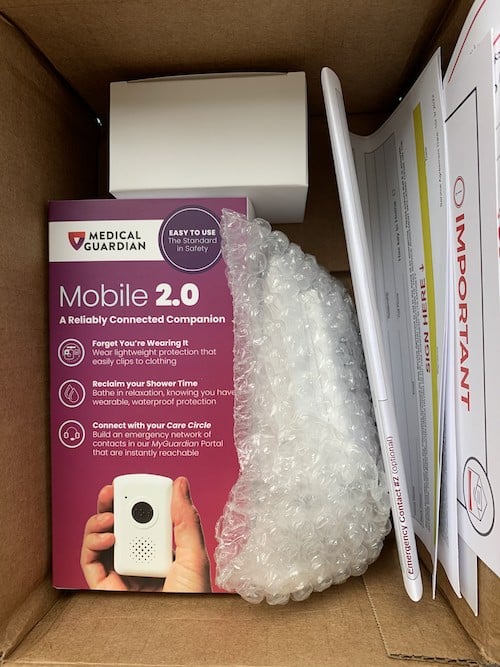
1. Features
First impressions are crucial when trying a new product. Our Reviews Team noted the packaging and unboxing experience, as well as each device’s dimensions and weight. When removing the medical alert systems from the packaging, our Reviews Team considered whether it would be simple or difficult to open for someone with limited mobility, arthritis, or other dexterity issues. The MobileHelp Touch Classic, for example, came in rigid plastic molding that required significant effort to open.
We recorded if each system had the following standard features:
- Advertised range between help button and device
- Landline or cellular LTE connection
- Global position systems (GPS) location tracking (using satellites to pinpoint your location)
- Two-way speaker to speak with a monitoring center staff member
Our Reviews Team also noted if any of the following special features were available:
- Fall detection
- Air quality and temperature monitoring
- Accommodations for hard of hearing: lights, vibrations, and other visual cues
- Heart rate monitor
- Local weather forecast
- Lockbox (box to store a spare set of keys for emergency services to enter your home in the event you are incapacitated)
- Medication reminders
- Step tracker
- Voice recognition to call the monitoring center with your voice
2. Functionality
After the personal emergency response systems were unboxed, measured, and weighed, it was time for our Reviews Team to set up the systems in their homes. We evaluated the installation process by noting if a user guide or instruction manual was included with the system, if the company provided step-by-step testing instructions, how many steps it took to set up the system, and if we had to call the company to activate the system.
We tested the overall functionality of each medical alert device by testing and recording the following:
- Accuracy of advertised range between the help button and device
- Button size
- Ease of pressing buttons
- On-screen text size (if applicable to the specific system) and the ability to adjust the size of the text for better readability
- Clarity and reach of two-way speaker
- Voice recognition accuracy
Connection range
At-home systems include a help button that fits in a medical alert bracelet or necklace. When you press the help button within a certain range of the base station, it contacts the monitoring center. This was an important feature to test, so that our Reviews Team could accurately report the reliability of this feature for each brand. The advertised range proved true for the Medical Guardian Home 2.0, Medical Alert Home System, GetSafe, and all ADT Health systems. The LifeStation At Home system recorded the most significant range discrepancy, as the pendant disconnected from the base unit at 75 feet instead of 1,000 feet.
The personal emergency response system’s base unit and help button communicate via radio frequency, so the connection range may vary depending on environmental obstructions like thick walls.
On-the-go systems and medical alert smartwatches connect to the monitoring center wherever cellular service is available, whether you’re at home or on-the-go. Most medical alert systems use AT&T or Verizon cellular service to connect to the monitoring center, and you can check a brand’s website or call customer service to see which cell service provider they use. You don’t need to be an existing customer of these cellular providers—medical alert companies contract to use the provider’s network. Before purchasing your medical alert device, make sure you have reliable coverage with the brand’s cellular service provider by reviewing the AT&T Wireless Coverage Map or Verizon Coverage Map.
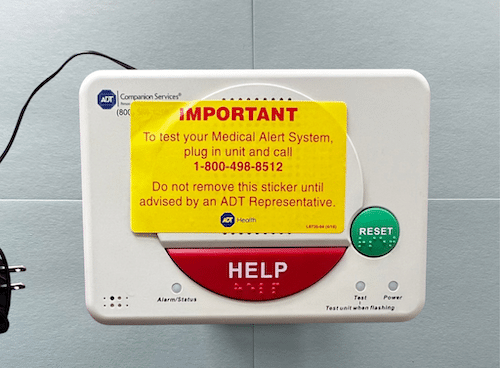
Button functionality
Our Reviews Team noted each system’s button size and the ease of pressing them to evaluate the functionality for all users. Since mobile systems are more compact and generally have smaller buttons than at-home systems, certain models may be more challenging for some to operate.
The ADT On-the-Go system has a large help button in the center, but the power and test buttons on the side of the device are small and hard to push. The Micro mobile system from MobileHelp also has small power and test buttons that are difficult to push. We had to press the Micro help button for at least two seconds before the system called the monitoring center. Our Reviews Team concluded that someone with reduced dexterity or arthritis may have trouble navigating the MGMove smartwatch’s touchscreen.
We like that the Unaliwear Kanega Watch is designed to look like a touchscreen smartwatch—without the touchscreen. Our Reviews Team connected to the monitoring center and performed other functions by using verbal commands or pressing the main “crown” button on the side of the watch face. The crown button was easy to find by feel, didn’t require a hard press, and always had a distinct click when pressed successfully.
Two-way speaker
A personal emergency response system’s two-way speaker allows you to speak with the monitoring center staff from your device. It’s crucial to verbally confirm whether you need emergency services, you’re calling for a non-emergency, or you’re testing your device. If you contact the monitoring center with your help button and the main system is a few feet away or in a nearby room, you should be able to hear and speak with the staff member on the other end.
Medical Guardian, MobileHelp, and ADT at-home systems had the strongest two-way speakers: Our Reviews Team could hear and speak with the monitoring center staff 15–20 feet away from the base station. The Bay Alarm Medical SOS Home speaker strength was the weakest, and the farthest we could communicate with monitoring staff was from only 6 feet away.
Voice recognition
Siri from Apple and other voice-recognition technology like Amazon Alexa and Google Home have become part of everyday life for many people, and many medical alert devices are adopting this technology.
Users can call the monitoring center with verbal commands with Aloe Care Health, GetSafe, and Unaliwear (Kanega Watch), while Bay Alarm Medical SOS Smartwatch, the HandsFree Health necklace, and MobileHelp Touch Classic offer voice commands for features, like voice-to-text messaging or reminders.
The Aloe Care Health Smart Hub voice recognition was not reliable during tests. Our Reviews Team programmed the base station to call the monitoring center after saying “emergency” twice, but we had to say it four to five times for a call to go through. The Smart Hub called the monitoring center three times when the team member testing the device was in various meetings, even though they never said “emergency.”
3. Safety features
Certain personal emergency response systems safety features help caregivers simplify and coordinate care for their loved ones. Our Reviews Team chose the top features that offer potentially lifesaving monitoring for older adults. Many of these features give caregivers an active role in caring for their loved ones.
Our Reviews Team evaluated the following safety features:
- Fall detection
- GPS location tracking
- Check-in services
- Caregiver app
Fall detection
According to the Centers for Disease Control and Prevention (CDC), three million older adults are treated in emergency rooms for fall injuries every year, making fall detection an important feature for many personal emergency response system users. [1]Facts About Falls. Centers for Disease Control and Prevention. Aug. 6, 2021. Found on the internet at https://www.cdc.gov/falls/facts.html. In fact, in a survey of 1,000 medical alert system users and caregivers conducted by our Reviews Team, automatic fall detection was the top special feature survey respondents wanted included with their system. [2]NCOA Adviser Medical Alert System Survey. 1,000 respondents. Conducted using Pollfish. Launched Nov. 11, 2022.
“Getting help in a timely fashion in the event of a fall prevents a number of possible complications that can result from a fall,” said Christopher Norman, a geriatric nurse practitioner based in New York state. These complications include muscle breakdown, damage to major organs, excessive anxiety, and more, which can be life-threatening to older people, he noted.
Not only that, but falling and lying on the floor for more than an hour after a fall (also called a “long lie”) has serious consequences. Experiencing a long lie is associated with muscle damage, pneumonia, pressure sores, dehydration, and hypothermia, according to research from Cambridge University. [3]Lord, Stephen R., and Catherine Sherrington. Falls in Older People: Risk Factors and Strategies for Prevention. Cambridge University. January 2001. Found on the internet at https://www.researchgate.net/publication/242236092_Falls_in_Older_People_Risk_Factors_and_Strategies_for_Prevention. The same research found that half of those who lie on the floor for an hour or longer after a fall die within six months, even if there is no direct injury from the fall. A feature like fall detection, which can automatically alert emergency services that you’ve fallen, can drastically reduce the amount of time you remain on the floor after a fall.
If you add fall detection to your at-home medical alert system, you’ll receive a designated fall-detection necklace with a built-in sensor that automatically contacts the monitoring center if it detects downward motion.
Mobile medical alert devices with fall detection come with the feature built into the device or include a fall-detection necklace (also called a lanyard or pendant) as an additional accessory. Our Reviews Team evaluated brands based on the following:
- Fall detection availability
- Fall detection accuracy
- Inclusion of fall detection testing instructions
We took all of this information into account when determining the best fall detection devices. Most devices successfully passed multiple drop tests, except for the Apple Watch with Lively Monitoring, which never went off. The Kanega Watch by Unaliwear also performed poorly in drop tests, registering two out of six falls.
GPS location tracking
During multiple phone calls to test GPS location tracking, our Reviews Team asked monitoring center staff our location and were given accurate (or nearby) locations almost every time. An ADT monitoring staff member was the only one that couldn’t see our location at all when we tested the On-the-Go system.
Check-in services
LifeFone was the only brand to offer daily check-in services as an add-on. Our Reviews Team added this service to the LifeFone At-Home & On-the-Go VIPx® and received a check-in call on our mobile system at the same time every day from the monitoring center staff. The caller was friendly, and if we didn’t answer the first call, they left a voicemail and called us again.
Our Reviews Team likes that LifeFone doesn’t immediately dispatch emergency services if the medical alert system user doesn’t answer a check-in call. Instead, the monitoring center staff follows a user’s emergency care instructions and calls designated emergency contacts to check in on the user’s location and well-being before sending emergency responders to their location.
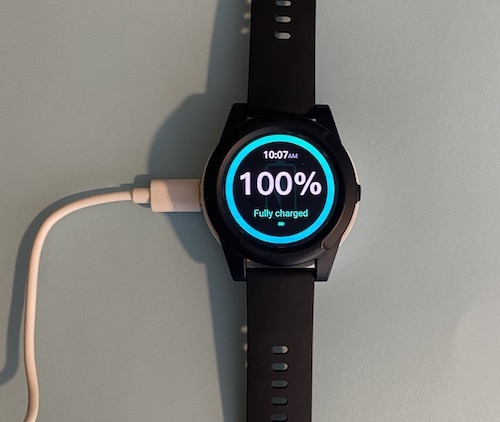
4. Battery life and charging
Battery life is a critical feature since a dead or low battery can mean a lapse of protection. To evaluate the battery and charging features for each model, we considered the following:
- Battery life and performance
- Presence of low battery notifications
- Charge time
- Ease of placing device on charging cradle
- Verbal or visual alert indicating device needs charging or battery replacement
- Charging cord type: USB-A, USB-C, micro-USB, or proprietary
- Charging cord length
At-home medical alert systems are always plugged into an outlet and have a built-in backup battery that lasts 5–32 hours, depending on the device, if the power goes out. Most mobile systems and smartwatches include built-in rechargeable batteries and a charging cradle that plugs into an outlet. Depending on the brand, how often you use the device, and how often a caregiver checks its location, the battery can last multiple hours to multiple days between charges. Medical alert smartwatches often have a much shorter battery life (8–36 hours) than mobile systems since they have more advanced functions.
Based on our tests, it takes two to four hours for most mobile medical alerts to reach a full charge.
No one should be surprised by a dead battery when using a medical alert system. All systems notified our Reviews Team when the battery was running low, whether verbally, visually, with vibration, or a combination of the three. The LifeFone VIP Active® low-battery notification was so loud it woke up a Reviews Team member in the middle of the night.
The charging cord length helps determine where you place your medical alert system. The longer the cord length, the less you have to worry about putting it right next to an outlet—especially if the outlet isn’t in a central location.
- Longest charging cord length: Lively Mobile+ (8 feet)
- Shortest charging cord length: Unaliwear Kanega Smart Watch (1.5 feet)
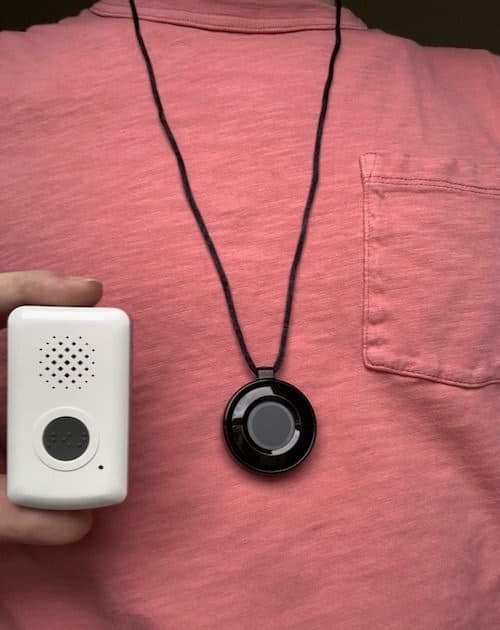
5. Wearability
Whether you wear your medical alert device as a bracelet or necklace, it should be comfortable to wear throughout the day. Our Reviews Team evaluated the comfort and wearability of the following accessories:
- Help button bracelet and necklace
- Fall detection necklaces
- Mobile system necklaces
- Smartwatches
Our Reviews Team considered these factors when testing wearability and comfort:
- Options to receive a bracelet or necklace for at-home systems
- Ease of switching help button between the bracelet and necklace
- Weight
- Adjustability
6. Monitoring center and response time
The 24/7 connection to a monitoring center is the most important medical alert system feature. A fast response time can make a lifesaving difference during a medical emergency. Almost 70% of respondents ranked fast response time as the most important medical alert system feature in the survey conducted by the Reviews Team.
Our Reviews Team tested each model three or more times to see how quickly we connected with the monitoring center staff after pressing the help button. We noted the following when contacting the monitoring center:
- Length of time between activating an emergency call and speaking to monitoring center staff
- Accuracy of location identification by monitoring center staff
Monitoring centers were also evaluated by the following features:
- Presence of multiple monitoring center locations and/or generators for backup
- Whether the center is based in the United States
- Availability of multilingual operators
- Whether caregivers are notified when the user calls the monitoring center
Medical Guardian, Bay Alarm Medical, MobileHelp, Aloe Care Health, and GetSafe all had impressive average response times of one to 25 seconds. Unaliwear and ADT had the slowest response time, averaging more than 45 seconds to reach a monitoring center staff member.
All brands in our testing summit have monitoring centers based in the United States and are Five Diamond Certified by the Monitoring Association, which confirms that staff have undergone advanced training and the center is subject to rigorous testing.
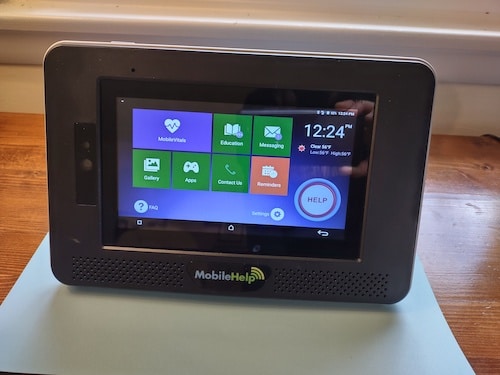
7. App accessibility
In the last 10 years, apps that correspond with medical alert devices have become a huge perk for users and caregivers. Many apps allow you to manage your account billing, update and edit emergency contact information, and track the device location.
An app is only as helpful as it is accessible and simple to use. Our Reviews Team noted the following when rating app function and accessibility:
- Time to install and set up
- App features
- Connectivity
- Ease of use
- Option to add caregiver
The following medical alert brands include an app for users and caregivers:
- Aloe Care Health
- Bay Alarm Medical
- GetSafe ($5 per month)
- HandsFree Health
- LifeFone
- Lively
- Medical Alert
- Medical Guardian
- MobileHelp
Our Reviews Team found the GetSafe and Medical Alert app features limited compared to other brands. The GetSafe app is also the only one we had to purchase, and it’s mainly used for location tracking and history.
ADT, LifeStation, and Unaliwear do not have an app.
8. Customer service
Supportive, reliable customer service representatives can help you navigate the many features and functions of your medical alert system. From helping you choose a subscription to troubleshooting equipment and billing issues, a helpful customer service representative can make a huge impact on your experience.
Our Reviews Team stayed in contact with customer service representatives throughout our testing summit. We rated each brand’s customer service according to the following:
- Availability
- Helpfulness
- Communication options (phone, email, and/or live chat)
- Wait time to speak with a live representative
- Availability of multilingual operators
Our Reviews Team had generally good experiences with the 12 medical alert system brands. We never waited more than five minutes to reach a live customer service representative, and some wait times were especially quick. It only took 20–30 seconds for our Reviews Team to speak with a representative when contacting HandsFree Health, LifeStation, Medical Alert, and Unaliwear customer service.
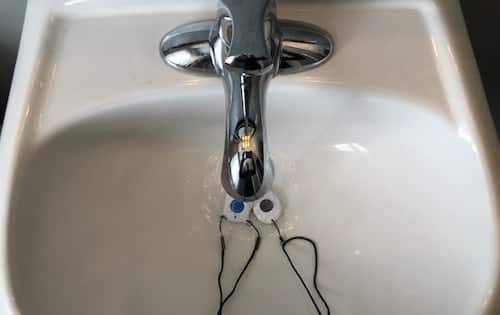
9. Durability
When you own a medical alert system, it becomes a part of your everyday life, whether you wear it as a bracelet, necklace, or clipped to your purse or pocket. Wearable medical alert devices should be designed to travel with you almost everywhere. Our Reviews Team tested the durability of medical alert bracelets, necklaces, mobile systems, and smartwatches. We did not include at-home base stations in the following durability tests:
- Water test: Exposing devices to water to test their advertised resistance to water
- Drop test: Dropping devices repeatedly from a predetermined height to gauge durability
Mobile systems and smartwatches are either waterproof or water resistant. Most companies assign an ingress protection (IP) rating to the device to indicate if it’s waterproof (IP X7) or water-resistant (IP X6). Brands may include the IP rating in the product manual or state the device is waterproof or water resistant without including the official IP rating.
- Waterproof: The device can be fully submerged in water for a long period of time and still work properly.
- Water resistant: The device can get splashed with water and still work properly, but it should not be submerged in water.
It’s important for medical alert devices to be made with waterproof and water-resistant material, so you can stay constantly connected to the monitoring center even while showering or bathing. All devices passed the water tests except for the Medical Guardian Mobile 2.0 (discontinued), which could not contact the monitoring center after being submerged in 6 inches of water for 25 minutes.
“Every time a person takes a device off, that person needs to remember to put it on again,” said Norman. “In this day and age of technology, why not make a device that will accommodate a person’s lifestyle, rather than make the person accommodate the device?”
10. Ordering process and return policy
Our Reviews Team evaluated the entire ordering and return process for each brand. It was simple to purchase models online directly from each company’s website. The only purchase our Reviews Team had to make over the phone was Lively on Apple Watch, and it was the most complicated ordering process of our testing summit.
When we called to purchase the Lively app, most customer service representatives didn’t know how to add a Lively package to an Apple Watch already in use. Our Reviews Team was transferred 10 times and disconnected four times until we finally spoke with a representative who helped us.
If you’re more comfortable purchasing your medical alert device over the phone than ordering online, this is an available option for all 12 brands.
Every brand in our testing summit also has a 30-day return policy, meaning you’ll get a refund if you return the device within 30 days of receiving it. While the GetSafe website states it has a 30-day return policy, the paperwork says there is a seven-day return window from the purchase date. Our Reviews Team clarified with a customer service representative that there is still a 30-day trial window.
ADT and Aloe Care Health are the only brands that cover return shipping fees. Our Reviews Team received a prepaid return label from both brands once we canceled our subscriptions, and ADT also delivered a new box to ship our devices back to the company.
How we tested personal emergency response systems
Our Reviews Team performed hands-on tests to see how medical alert devices work in common, day-to-day situations. See a step-by-step breakdown of our range, fall detection, GPS location, app, and durability tests below.
Range test for at-home systems
Our Reviews Team tested the accuracy of each advertised range for at-home systems by conducting the following two-person test procedure:
- Step 1: While wearing the necklace or bracelet, our Reviews Team member measured each accessory’s range from the base station (this was more than three blocks away for some at-home systems).
- Step 2: One tester brought the help button to the farthest point of the range, while their testing partner remained next to the medical alert system.
- Step 3: The Reviews Team member at the farthest point pressed the help button, and the testing partner confirmed whether the medical alert system successfully contacted the monitoring center.
- Step 4: If the help button successfully contacted the monitoring center at the farthest range, the system’s range was deemed accurate.
- Step 5: If the help button didn’t contact the monitoring center, the outside Reviews Team member walked approximately 100 feet toward the base station and pressed the help button again. This step was repeated until the help button was connected to the monitoring center.
Our Reviews Team recommends using the above procedure to test your system’s maximum range, so you’ll know the farthest range your help button can contact the monitoring center. Based on testing, our Reviews Team found each advertised range was accurate.
Fall detection test
Because it’s difficult (and unsafe) to replicate a fall, many brands provide specific instructions to test fall detection. Our Reviews Team conducted the following test procedure if a brand didn’t include fall detection testing instructions:
- Step 1: While standing, our Reviews Team held the device at shoulder height.
- Step 2: Next, we dropped the device.
- Step 3: After leaving the device on the ground for 20–30 seconds, we waited for the device (or base station for at-home systems) to ring, beep, and/or verbally confirm it was connecting to the monitoring center.
- Step 4: If we connected, we confirmed with monitoring staff that we were testing the device. If the device didn’t connect to the monitoring center, the fall detection test was unsuccessful.
Our Reviews Team conducted this test multiple times for each device with fall detection. We realized if we picked up the device within a few seconds of dropping it, it often didn’t connect to the monitoring center.
This wasn’t the case for all systems, but Lively Mobile+, Aloe Care Health Mobile Companion, and WellBe Medical Alert Pendant didn’t connect to the monitoring center if we picked up the device too quickly after dropping it. All four models successfully connected to the monitoring center once our Reviews Team kept the devices on the ground for up to 30 seconds.
While a 2016 study [4]Gjoreski M, et al. How Accurately Can Your Wrist Device Recognize Daily Activities and Detect Falls? Sensors. June 1, 2016. Found on the internet at https://www.mdpi.com/1424-8220/16/6/800 reported that fall detection devices worn on the left wrist showed more accuracy than the right wrist or chest, research has shown that quick, jerky, or even normal hand movements can cause false alarms. [5]Javier González-Cañete, Francisco and Casilari, Eduardo. A Feasibility Study of the Use of Smartwatches in Wearable Fall Detection Systems. Sensors. March 23, 2021. Found on the internet at https://www.mdpi.com/1424-8220/21/6/2254. More recent data shows that wearing a fall detection device at the chest level (around the neck) provides the highest accuracy. [6]Lee, Yongkuk, et al. Experimental Study: Deep Learning-Based Fall Monitoring among Older Adults with Skin-Wearable Electronics. Sensors. March 2023. Found on the internet at https://www.mdpi.com/1424-8220/23/8/3983
Lively on Apple Watch and Unaliwear Kanega Watch were the only wristband-style devices with fall detection tested by our Reviews Team. Despite multiple tests, the Apple Watch never triggered fall detection, and the functionality of the Lively app, which gives Apple Watch users access to the monitoring center and app features, was inconclusive. The Kanega Watch triggered fall detection in two out of six tests.
Almost all brands included a disclaimer that their fall detection technology is not 100% accurate.
GPS location test
Mobile medical alert devices and smartwatches use global positioning system (GPS) technology to track the user’s location. This is a critical feature that allows the monitoring center staff to dispatch emergency services as close as possible to the user.
Location accuracy is different from location monitoring, but uses the same GPS technology. Medical alert systems with location monitoring allow caregivers to track their loved one’s location when they’re wearing the mobile medical alert system or smartwatch.
Our Reviews Team tested the accuracy of the GPS location services in each model by conducting the following test:
- Step 1: Our Reviews Team walked or drove a short distance away from their residence or testing location.
- Step 2: Once they were a distance away, they pressed the help button to connect to the monitoring center.
- Step 3: After monitoring center staff answered, they let them know they were conducting a test and asked them to identify our current location.
- Step 4: Then, they repeated the test three times.
- Step 5: Our Reviews Team made note of any issues, inconsistencies, and other comments.

Personal emergency response systems apps
While our Reviews Team tested all nine available apps, we wanted to highlight Bay Alarm Medical, Aloe Care Health, and Medical Guardian as offering the best apps.
Bay Alarm Medical
The Bay Alarm Medical My Account Manager app keeps general account information as well as specifics like device status, location, and step tracking in one place.
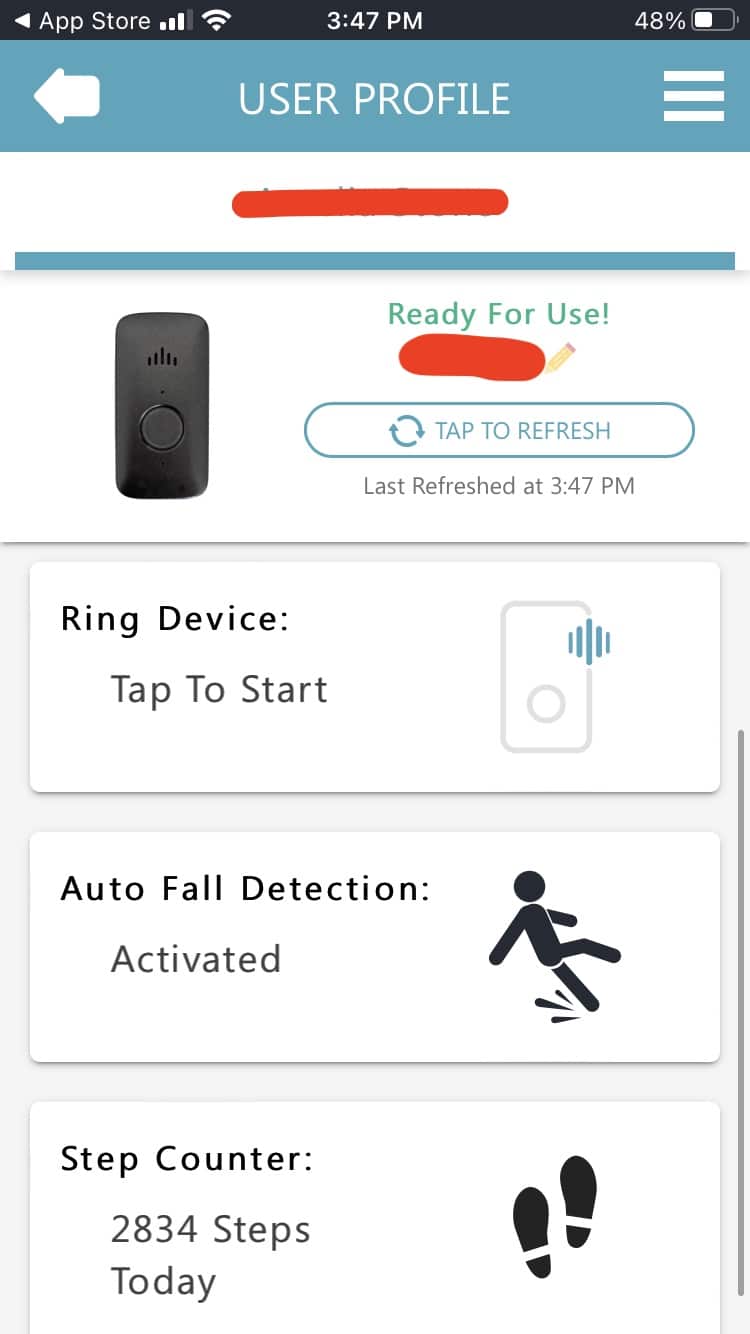
Our Reviews Team liked that we could manage our billing and update our emergency plan in the app. We could customize our emergency plan by listing emergency contact priority, who (if any) should be called before monitoring center staff dispatches emergency services, who has keys to the user’s home, the location of a hidden key, and whether there is a gate or lock code.

The app has unique features for Bay Alarm Medical mobile devices. We could “ring” the system if it was misplaced or lost, and we could monitor our step tracking when wearing the mobile device. These features are not available for at-home systems.
Aloe Care Health
The Aloe Care Health app is designed mainly for caregivers, and our Reviews Team had trouble connecting to the app as the medical alert system user. We called customer service and learned the primary caregiver must activate the app with a code. Once our Reviews Team got that information, we were able to quickly set up the app.
Our Reviews Team liked that medication reminders, health, and other care information can be added to a “Health Card” in the app.

The Aloe Care Health app’s activity feed logs daily activities such as the user’s movement, calls to the Smart Hub base station, and if they call the monitoring center.
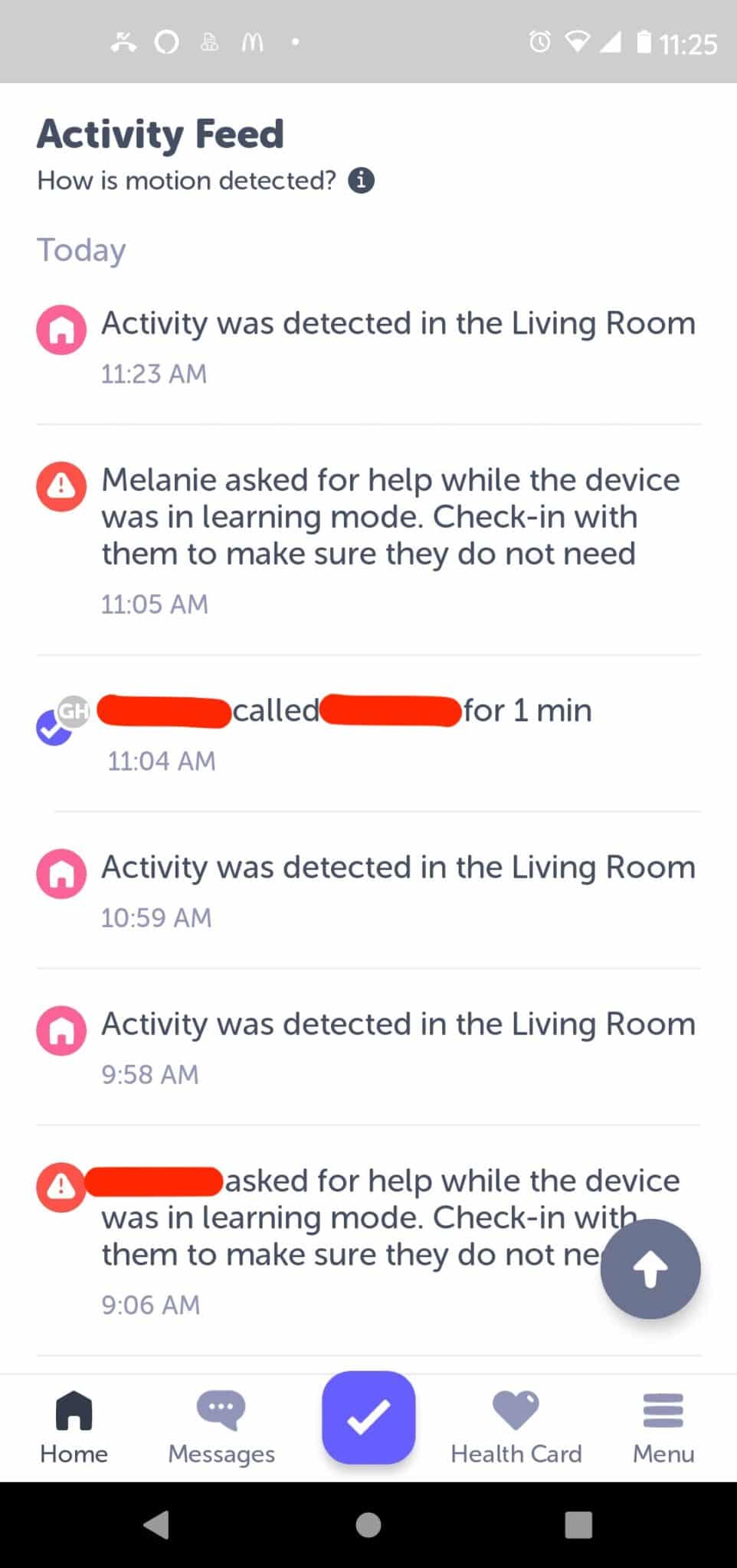
Medical Guardian
The Medical Guardian MyGuardian app allows users and caregivers to get an overview of the system by displaying battery status, connection status, and billing information. You can also set up medication reminders in the app if you purchased this additional feature.
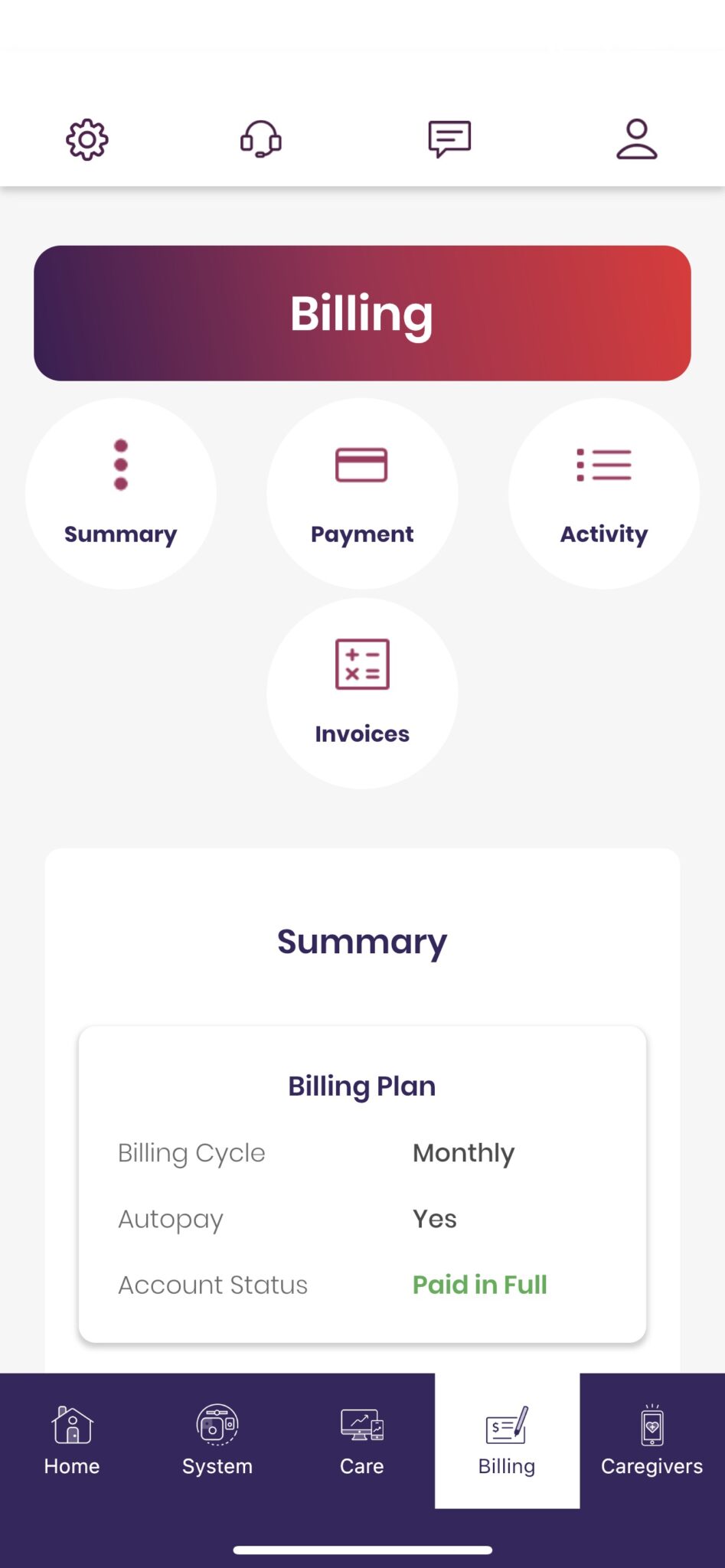
The app also integrates with Google Maps to show the device’s location in real-time. This is a great feature to easily check in on your loved one’s location whenever they’re wearing the system.
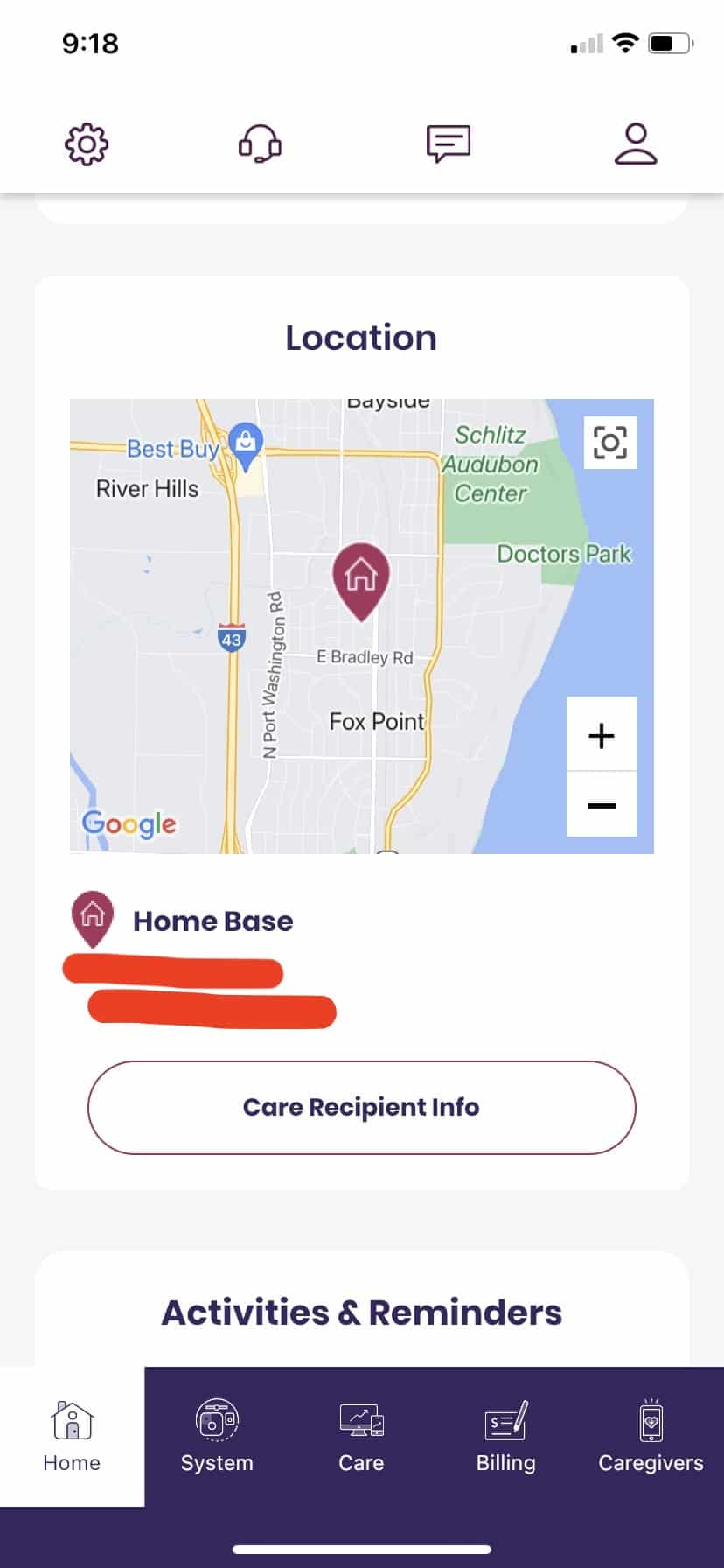
Durability tests
Our Reviews Team conducted the following drop test to evaluate the durability of our mobile systems, fall-detection necklaces, and standard help button necklaces and bracelets:
- Step 1: To begin, our Reviews Team tested the device functionality to make sure it was working properly.
- Step 2: If possible, we then turned off the automatic fall detection.
- Step 3: To avoid scratching the device, we found a hard surface with a fabric mat or carpet on top.
- Step 4: Next, we dropped the device from about five feet.
- Step 5: Finally, we picked up the device to check for functionality, scratches, and any other damage.
- Step 6: We repeated this process 10 times.
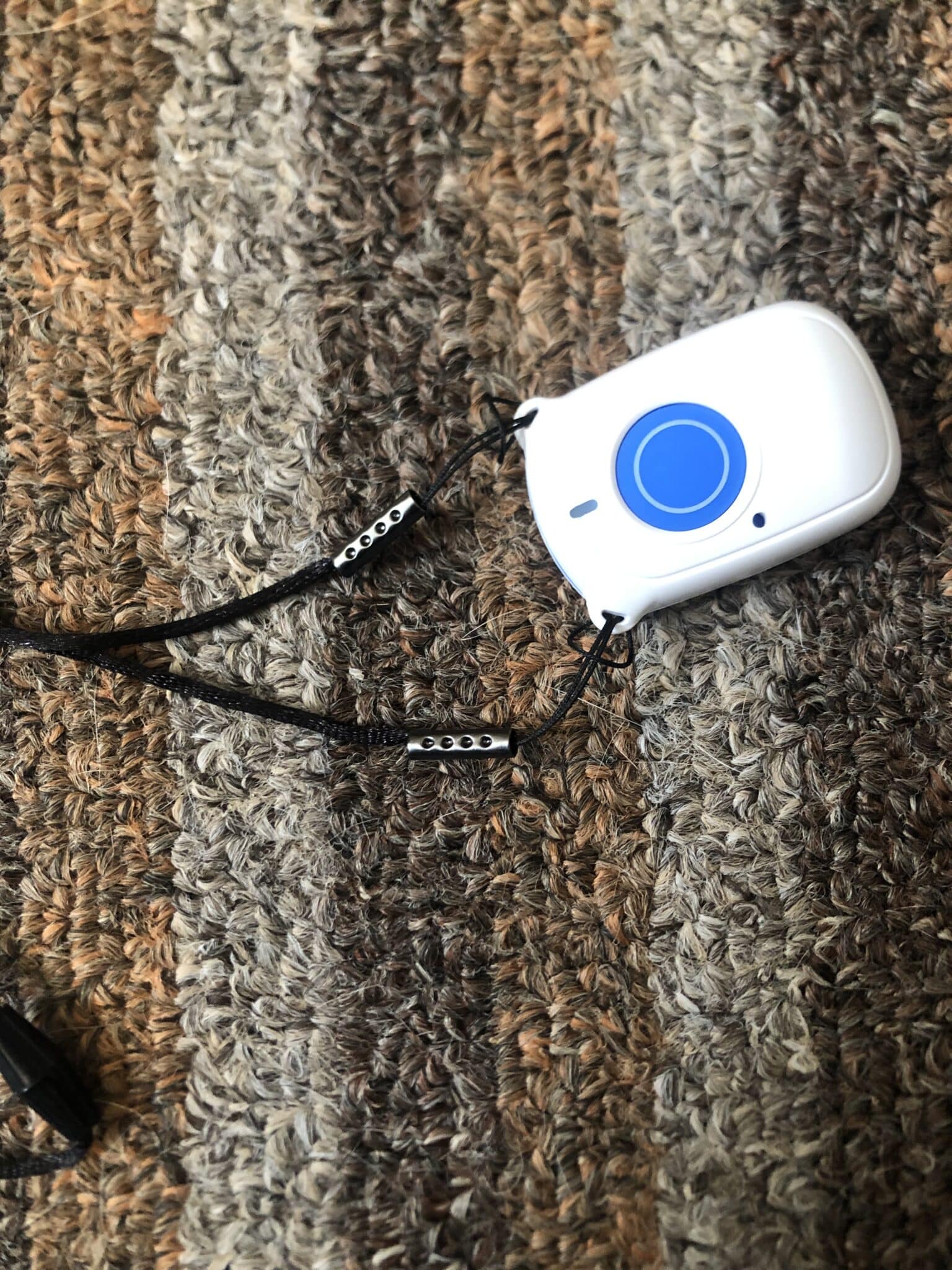
Our Reviews Team had a separate test procedure for waterproof devices vs. water-resistant devices. We conducted the following test for water-resistant devices to simulate activities like showering and washing the dishes while wearing a medical alert device:
- Step 1: First, our Reviews Team tested the device functionality to make sure it was working properly.
- Step 2: Next, we placed the device under a shower head, faucet, or hose stream and turned it on.
- Step 3: We then set a timer for one minute.
- Step 4: When the timer went off, we removed the device from under the water stream and turned off the water.
- Step 5: To remove excess water, we patted the device dry with a paper towel.
- Step 6: Finally, we tested the device functionality.
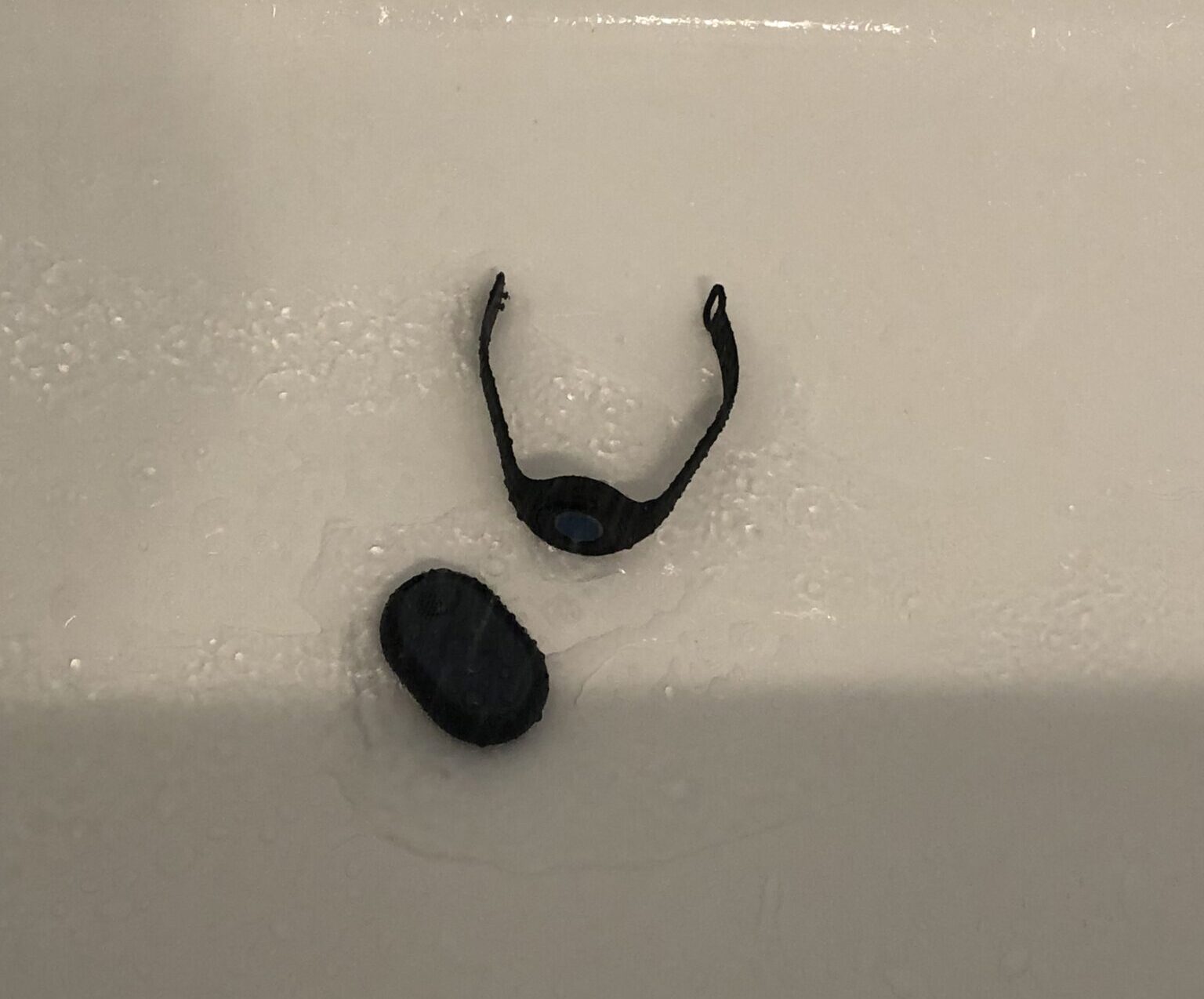
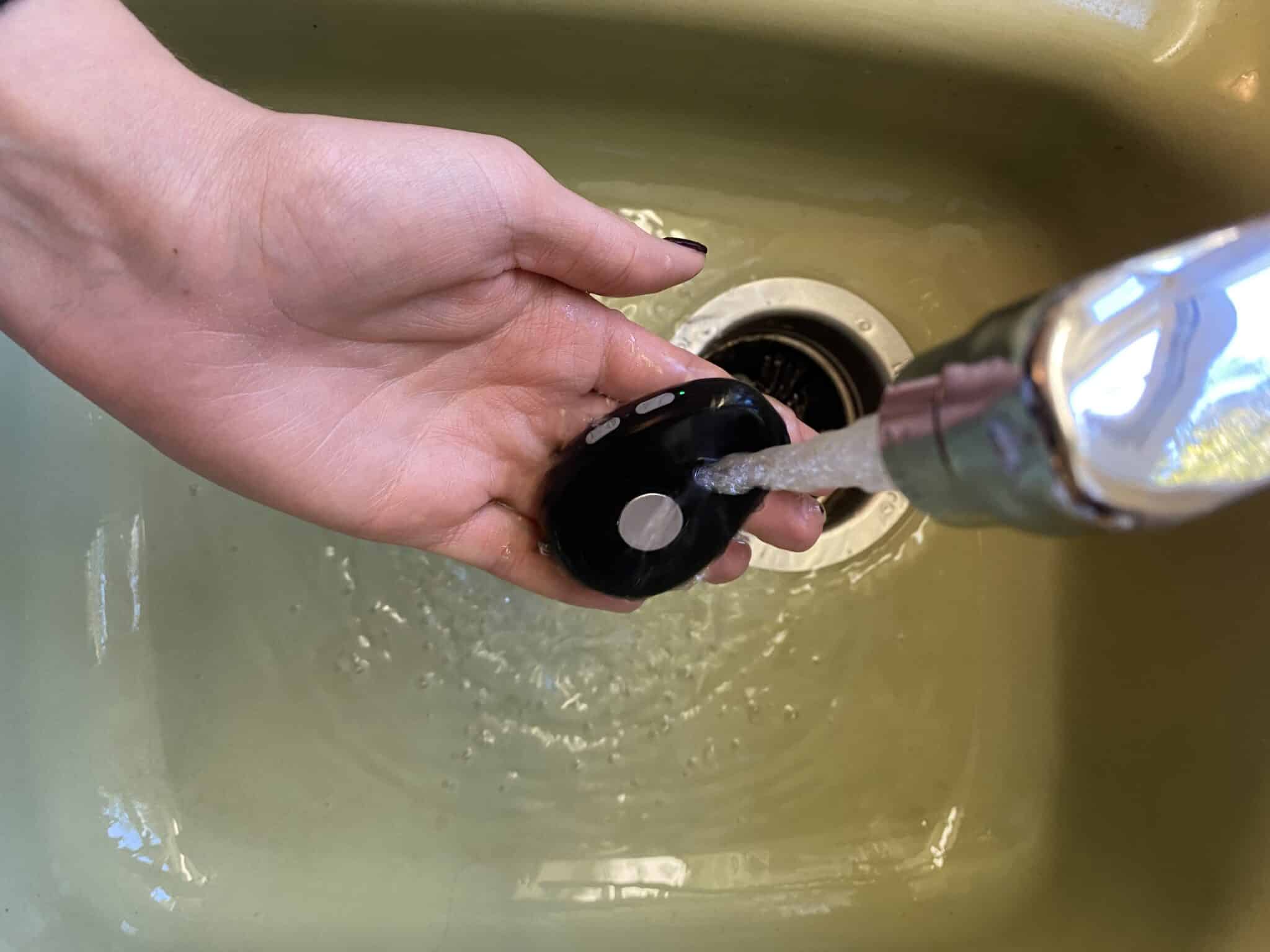
Our Reviews Team tested waterproof devices with a submersion test to simulate swimming or bathing while wearing a medical alert system:
- Step 1: First, our Reviews Team tested the device functionality to make sure it was working properly.
- Step 2: Next, we filled a sink or tub near the top with water.
- Step 3: Then, we dropped the device in the sink or tub.
- Step 4: We set a timer for 30 minutes.
- Step 5: When the timer went off, we removed the device from the water.
- Step 6: To remove excess water, we patted the device dry with a paper towel.
- Step 7: Finally, we tested device functionality.
The Medical Guardian Mobile 2.0 (discontinued) was the only device that did not hold up to the waterproof claim. After performing the above test, our Reviews Team could hear water sloshing inside the Mobile 2.0, and it wouldn’t contact the monitoring center after pressing the button multiple times. Our Reviews Team thought this was interesting since the brand’s other waterproof devices, the at-home necklaces, Mini Guardian (discontinued), and MGMove Smartwatch, passed the waterproof test.
Testing experience
Our Reviews Team wore medical alert necklaces, bracelets, and mobile devices throughout our testing summit. We had them on while working, going to the grocery store, walking around our neighborhoods, cooking, and doing as many other day-to-day activities as possible. One tester wore their medical alert on a rollercoaster. Some team members even forgot they were wearing their devices because they were so lightweight and comfortable.
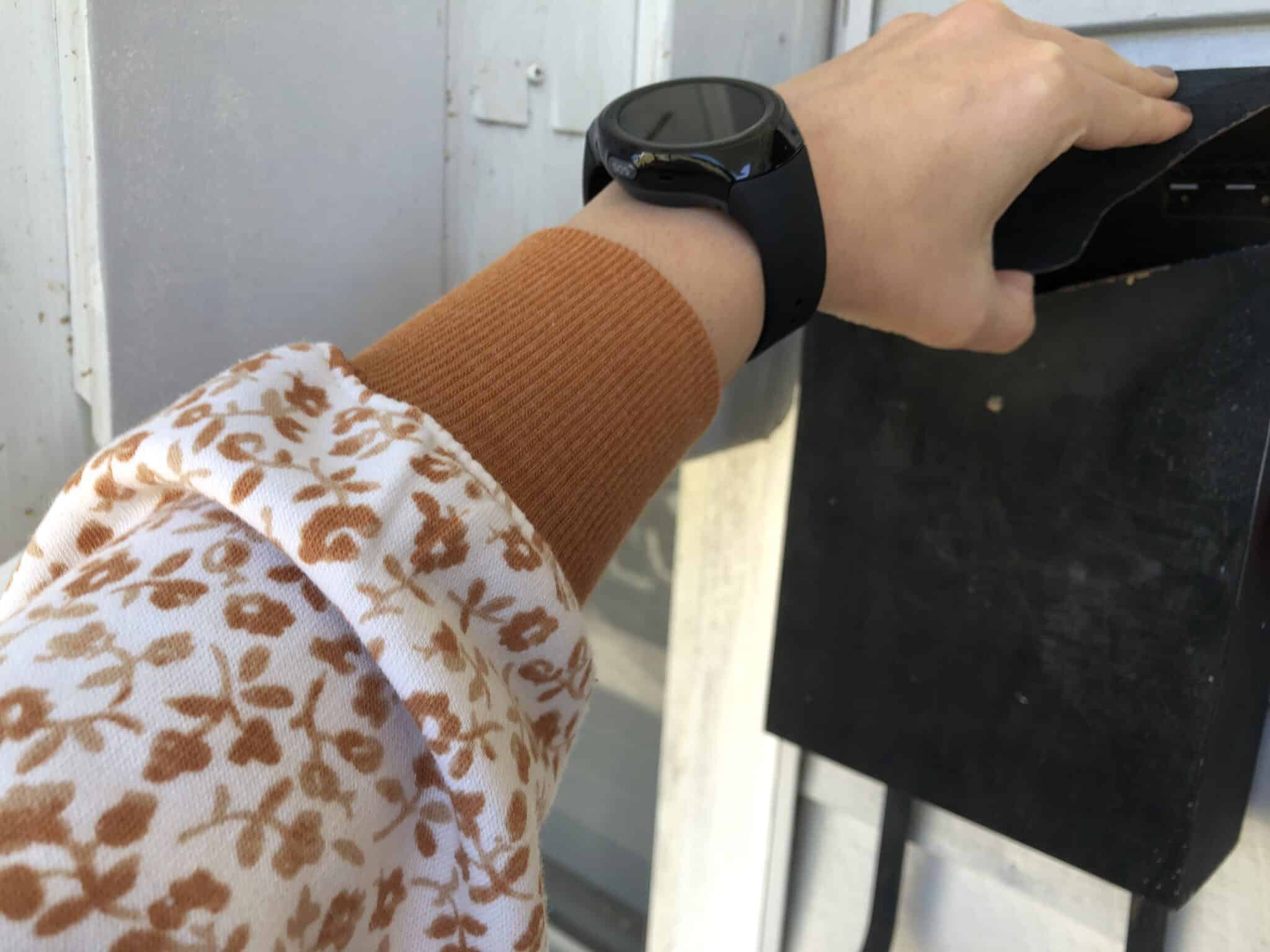

Our testing summit included a few surprises, but nothing topped the accidental emergency dispatch to our headquarters, which came from a medical alert system in a completely different state. When our Reviews Team made a test call to the monitoring center with the Unaliwear Kanega Watch, the watch rang for more than two minutes and didn’t connect to the monitoring center. The watch then verbally stated it was “experiencing some difficulty connecting” and went quiet. The tester ended the call since there was no response.
Within seven minutes of the call, two emergency service vehicles arrived at our Reviews Team’s headquarters. We realized the Kanega Watch was still registered at this address from a previous round of testing, and the monitoring center staff used this location when dispatching emergency services instead of the current GPS location of the Kanega Watch.
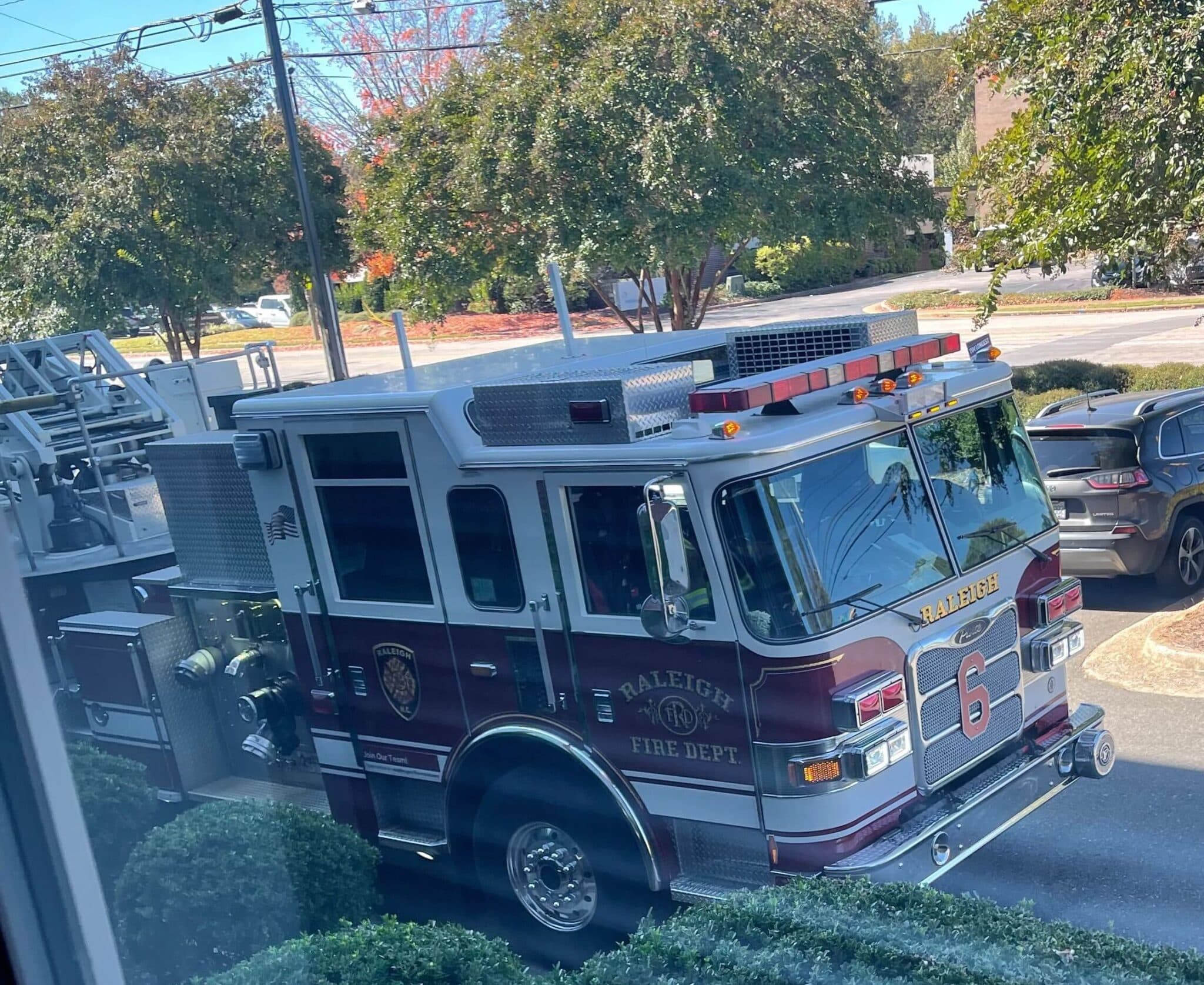
A Unaliwear company representative said the monitoring center didn’t pull up the device’s correct GPS location during the test call because the watch was in an area with poor cellular service. The Kanega Watch uses Verizon cellular service, but the Reviews Team member noted they have always had excellent coverage with Verizon in and around their home.
Our Reviews Team’s pets also couldn’t resist lending a hand (or paw) in the medical alert system testing summit.

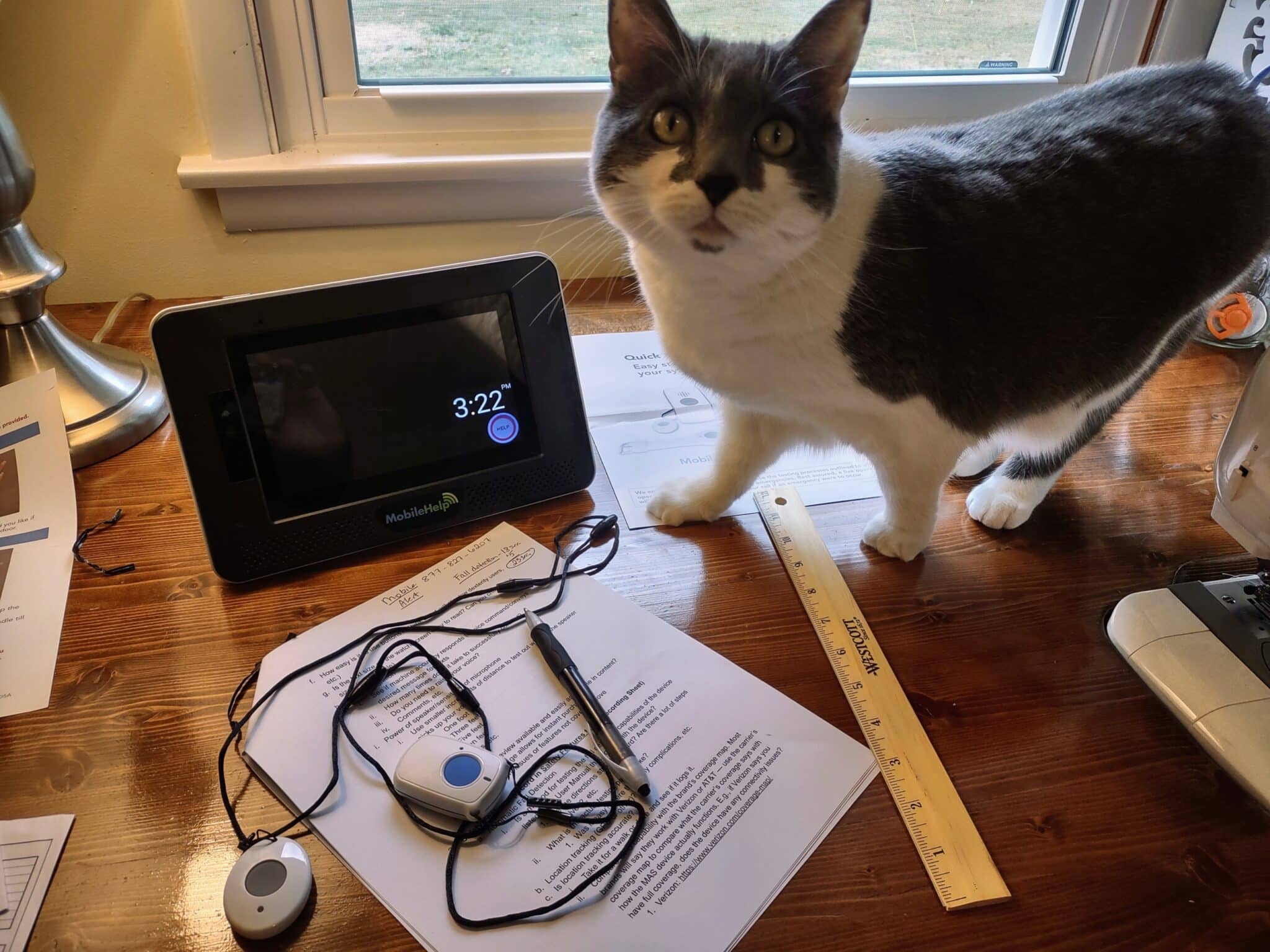


Testing Data and Results
Our Reviews Team scored the 12 brands we tested based on eight categories: monitoring center, customer service, brand reputation, wearable options, price, ease of use, safety features, and special features. See testing highlights for each brand below.
Bay Alarm Medical
Bay Alarm Medical offers a variety of at-home and mobile systems at an affordable price and was our Reviews Team’s highest scoring brand overall. Fast monitoring center response times, good customer service, and overall ease of use helped this brand stand out.
LifeFone
We like the simple check-in and reminder services available with LifeFone: monitoring staff calls the user daily to check in with them and give them any reminders for the day. These calls were quick and consistent throughout our testing summit—each call only lasted about 10 seconds.
Medical Guardian
The Medical Guardian MGClassic has the longest advertised range for a landline system—1,300 feet—tied only with the LifeFone landline system. Unfortunately, the MGClassic range didn’t hold up during our testing: The help button didn’t even connect 300 feet from the landline base station. The cellular at-home system, MGHome Cellular, did meet the 1,400-foot advertised range, and our Reviews Team liked the brand’s lightweight, compact mobile systems.
MobileHelp
Between landline, cellular, and smart tablet at-home systems, MobileHelp has the most at-home system options. All proved easy to set up and had loud two-way speakers.
Medical Alert
Medical Alert didn’t offer many standout features compared to other brands and has expensive monthly monitoring fees for such basic features and systems.
ADT
ADT offers three basic packages that are excellent for users wanting a low-tech, straightforward option backed by a well-known brand. Our Reviews Team had a great experience with customer service: We were always able to get in touch with them via the phone or online chat, and we like that the company takes care of shipping costs if you need to return your system. ADT tied with Unaliwear for the longest average response time at more than 50 seconds.
Aloe Care Health
Like ADT, Aloe Care Health also covers return shipping costs. Our Reviews Team recommends Aloe Care Health for caregivers who may need to closely monitor their loved one and check on them throughout the day. Our Reviews Team enjoyed making calls to loved ones with the Smart Hub base station, and we believe this is a valuable feature for users and caregivers. One of the biggest drawbacks of Aloe Care Health was its unreliable voice recognition technology.
GetSafe
The GetSafe voice-activated base station and wall buttons are excellent if you or your loved one don’t want to wear a necklace or may forget to put it on. Our Reviews Team tested the Select package, which came with a base unit and three wall buttons. We were impressed with the equipment’s speaker and voice recognition technology: The speakers were loud and clear, and we had no issues using verbal commands to call the monitoring center. Unfortunately, fall detection is only available if you purchase the mobile device, so we don’t recommend the brand for those with limited mobility or a higher likelihood of falling.
LifeStation
LifeStation has an at-home, mobile, and smartwatch system with standard features. The brand didn’t include helpful instructions or an online portal or app to handle account information. Our Reviews Team had to set up our account completely over the phone, including our emergency contacts and personal information.
HandsFree Health
The HandsFree Health medical alert necklace is highly effective for two-way calling: You can call and speak with your primary emergency contact directly from the necklace. Our Reviews Team also liked that we could set up daily reminders, medication reminders (including time and dosage amount), and medication refill reminders on the brand’s app.
Lively
Our Reviews Team recommends Lively if you’re interested in adding telehealth services to your medical alert system. The brand offers Nurse On-Call, an add-on feature that connects you to a nurse or board-certified doctor for medical advice and questions or to refill prescriptions (no insurance or copay required).
Unaliwear
Unaliwear is one of the first medical alert smartwatches to offer fall detection, but our Reviews Team was only able to trigger fall detection during about a third of our tests—two out of six times. We like the smartwatch’s unique battery structure: It includes four rechargeable batteries, two to place in the watch while the other two are charging, so you never have to take off the watch to charge it. The Unaliwear monitoring center also had one of the longest average response times: more than 50 seconds.
Table 2 Final scores from October 2022 medical alert system testing summit
| Brand | Overall Score (out of 5 points) | Monitoring Center (out of 6 points) | Customer Service (out of 15 points) | Brand Reputation (out of 3 points) | Wearable Options (out of 15 points) | Price (out of 6 points) | Ease of Use (out of 18 points) | Safety Features (out of 18 points) | Special Features (out of 12 points) |
|---|---|---|---|---|---|---|---|---|---|
| MobileHelp | 4.3 | 5 | 15 | 3 | 10 | 4.5 | 18 | 12 | 12 |
| Medical Guardian | 4.6 | 6 | 15 | 3 | 15 | 4.5 | 18 | 12 | 9 |
| Bay Alarm Medical | 4.7 | 6 | 15 | 3 | 15 | 4.5 | 18 | 15 | 9 |
| LifeFone | 4.6 | 5.5 | 15 | 3 | 13 | 5.5 | 15 | 17 | 8 |
| ADT | 3.7 | 6 | 15 | 3 | 12 | 4.5 | 18 | 12 | 9 |
| Aloe Care Health | 4.6 | 5 | 12 | 3 | 10 | 6 | 18 | 9 | 8 |
| GetSafe | 4.3 | 5 | 15 | 3 | 10 | 6 | 17 | 8 | 8 |
| Medical Alert | 4 | 5.5 | 15 | 3 | 10 | 4 | 17 | 13 | 6 |
| LifeStation | 3.6 | 4.5 | 13 | 3 | 14 | 4.5 | 13.5 | 7.5 | 9 |
| HandsFree Health | 4.4 | 4 | 9 | 3 | 9 | 4 | 16 | 12 | 12 |
| Unaliwear | 3.5 | 4 | 13 | 3 | 8 | 4 | 18 | 7 | 8 |
| Lively | 3.9 | 4.5 | 13 | 3 | 8 | 5 | 18 | 14 | 4 |
In summary: Few surprises during the testing summit
The testing summit’s highest-scoring brands—Bay Alarm Medical, LifeFone, and Medical Guardian—have been on our experts’ radar for years due to their reputations and safety features. Through hands-on testing in real-life scenarios, we confirmed that these brands deserve consideration from consumers. Only a few surprises, like poor water resistance in the Medical Guardian Mobile 2.0, came to the surface with these brands.
Larger problems were uncovered with low-scoring brands, like Unaliwear, with the Kanega Watch failing to connect to the monitoring center, and the Lively brand’s Mobile+, which takes a long time to recognize falls.
We hope all brands use our testing summit data to further internal research and development, and our Reviews Team looks forward to testing new iterations of all devices in the future.
Have questions about this article? Email us at reviewsteam@ncoa.org.
Sources
- Facts About Falls. Centers for Disease Control and Prevention. Aug. 6, 2021. Found on the internet at https://www.cdc.gov/falls/facts.html.
- NCOA Adviser Medical Alert System Survey. 1,000 respondents. Conducted using Pollfish. Launched Nov. 11, 2022.
- Lord, Stephen R., and Catherine Sherrington. Falls in Older People: Risk Factors and Strategies for Prevention. Cambridge University. January 2001. Found on the internet at https://www.researchgate.net/publication/242236092_Falls_in_Older_People_Risk_Factors_and_Strategies_for_Prevention.
- Gjoreski M, et al. How Accurately Can Your Wrist Device Recognize Daily Activities and Detect Falls? Sensors. June 1, 2016. Found on the internet at https://www.mdpi.com/1424-8220/16/6/800.
- Javier González-Cañete, Francisco and Casilari, Eduardo. A Feasibility Study of the Use of Smartwatches in Wearable Fall Detection Systems. Sensors. March 23, 2021. Found on the internet at https://www.mdpi.com/1424-8220/21/6/2254.
- Lee, Yongkuk, et al. Experimental Study: Deep Learning-Based Fall Monitoring among Older Adults with Skin-Wearable Electronics. Sensors. March 2023. Found on the internet at https://www.mdpi.com/1424-8220/23/8/3983.
- Stokke, R. The Personal Emergency Response System as a Technology Innovation in Primary Health Care Services: An Integrative Review. Journal of Medical Internet Research. July 14, 2016. Found on the internet at https://www.ncbi.nlm.nih.gov/pmc/articles/PMC4965612.




